By Brendon McCaron | 1 June 2011
Chopping and changing parts of your organisation might achieve quick savings but won’t solve your long-term budget problems. That requires rethinking your business model, starting with the outcomes sought and working out the best way to reach them. Brendan McCarron explains
 Saving money is a priority in the public sector at the moment. To do this, most organisations will try to incrementally improve what they do or the services they provide. But, as some are already finding out, piecemeal thinking and changes are not enough. There needs to be a much greater focus on changing the business models themselves, not just services, operations or technology.
Saving money is a priority in the public sector at the moment. To do this, most organisations will try to incrementally improve what they do or the services they provide. But, as some are already finding out, piecemeal thinking and changes are not enough. There needs to be a much greater focus on changing the business models themselves, not just services, operations or technology.
However, there is no common, understandable language to help people think about and communicate ideas on business models. One way to forge this is for leaders to cultivate a much clearer idea of the societal outcomes that their organisations seek to achieve and the factors that affect these outcomes.
This can be done by visualising the outcomes and the functions that affect them as chains of cause and effect. The assumptions behind the cause and effect links can then be identified and challenged and new ideas created. Here are ten steps to drawing up your chain.
Brendan McCarron is senior associate with CIPFA Training and Development and lead author of the CIPFA Finance Panel’s new book The performance pulse: managing performance to achieve strategic outcomes

Chopping and changing parts of your organisation might achieve quick savings but won’t solve your long-term budget problems. That requires rethinking your business model, starting with the outcomes sought and working out the best way to reach them. Brendan McCarron explains
 Saving money is a priority in the public sector at the moment. To do this, most organisations will try to incrementally improve what they do or the services they provide. But, as some are already finding out, piecemeal thinking and changes are not enough. There needs to be a much greater focus on changing the business models themselves, not just services, operations or technology.
Saving money is a priority in the public sector at the moment. To do this, most organisations will try to incrementally improve what they do or the services they provide. But, as some are already finding out, piecemeal thinking and changes are not enough. There needs to be a much greater focus on changing the business models themselves, not just services, operations or technology. However, there is no common, understandable language to help people think about and communicate ideas on business models. One way to forge this is for leaders to cultivate a much clearer idea of the societal outcomes that their organisations seek to achieve and the factors that affect these outcomes.
This can be done by visualising the outcomes and the functions that affect them as chains of cause and effect. The assumptions behind the cause and effect links can then be identified and challenged and new ideas created. Here are ten steps to drawing up your chain.
1. Define your terms
This might seem a cliché but it is still true. Outcomes are changes in the way people and communities think and act. Organisations can affect these only indirectly, through the products of their activities. Take an outdoor municipal swimming pool. Anything to do with designing, building and running the pool is not an outcome. Outcomes happen only when people use the pool, which eventually leads to changes in things such as a community’s health, prosperity and wellbeing.
2. Picture outcomes as a map of cause and effect chains
Minor changes in the way people think and act lead to larger and larger changes until the outcome you are aiming at happens. For example, an early outcome might be that people use the swimming pool, which influences them to join fitness clubs, which makes them eat more healthily and so on until, at last, you start to make an impact on the health outcome you were aiming for.
3. Analyse the early outcomes
This is important because these are the outcomes you can most easily influence. In the swimming pool example, people have to become aware of the pool’s existence, make a decision to use it and then come and swim. Plainly, if you cannot raise people’s awareness of the pool’s existence, then nothing else will happen. In general, the better organisations are at affecting these early outcomes, the more people will change the way they think and act in later parts of the chain.
4. Test the chains
It is important to get the direction of cause and effect right. For instance, take two propositions. The first is that people who read for pleasure at 16 are more likely to become managers in later life. The second is that the reason people read for pleasure at 16 and become managers is because they are brighter than average. Clearly, the two propositions could lead to quite different policy responses. You need to satisfy yourself that the causes you identify really do result in the effects you want and that there is not some other explanation. In terms of the direction of cause and effect, think about our swimmers and ask yourself how many come to the pool because they are already fit and healthy and for whom it is just another venue, as opposed to those who are attracted by the chance to keep fit.
5. Do plan for ‘wickedness’
Outcome chains are not going to be neat straight lines – it is likely that you will have to think through complicated branches of positive and negative effects. The trick is to focus on the more plausible ‘routes’ through the chains of outcomes, where the biggest potential positive effects and fewest negative effects occur. You might have data that helps you check the routes but just as important is a narrative that tells a convincing story of how one level of outcomes leads to another until your eventual outcome aim is achieved.
6. Now look at the activities
Once you have mapped the chain of outcomes you want to focus on, you need to move on to the activities you undertake to influence those outcomes. Think in terms of the functions that activities provide rather than departments or sections. For instance, a function is ‘to make people aware of the facilities of a swimming pool’. Responsibility for this function might be shared across a publicity section, a youth service and an education department.
7. Do look out for hidden functions
These include areas such as liaison and designing new services. Liaison with users and partners is a vital function that is rarely acknowledged as such, and therefore goes largely unmeasured and unmanaged. Senior managers spend a lot of time liaising but might miss the significance of what they do and the goodwill and business intelligence they gather.
8. Check out your outcome map
When you have identified the activities you should have an outcome map made up of cause and effect chains of ‘activity, early outcomes and aimed-for outcomes’. This can be used to create useful performance information. As a manager, you need to know if your plan is being deployed and is having the expected effect. So take one activity and ask yourself two questions: how will I know the extent to which this activity is/is not actually deployed and working as planned across my organisation? How will I know the degree to which this outcome is occurring in my targeted groups in the community?
9. Information is power
To answer the questions in 8, you need information – and that information is the basis of your performance indicators. For instance, to know if the activity is being deployed, you might check if the budget is being spent according to plan or not. It is relatively easy to test the degree to which early outcomes are occurring. For instance, a swimming pool can measure attendance. Later outcomes such as economic effects and improved health and wellbeing in communities might be harder to identify and attribute to the activities of your organisation. But unless you can identify shifts in these outcomes, you cannot justify your activities. In these cases, evidence that outcomes are not being achieved might be easier, faster and cheaper to gather.
10. Finally, there is no finally
Outcome maps and performance information have to be continuously updated as you try new ways of influencing outcomes and recognising when they change. Thinking in terms of outcomes helps you to maintain a focus on the results you want to achieve. You can use it to challenge your assumptions about the results desired, to make an impact on the outcomes and to work out the appropriate performance information.
Brendan McCarron is senior associate with CIPFA Training and Development and lead author of the CIPFA Finance Panel’s new book The performance pulse: managing performance to achieve strategic outcomes



















